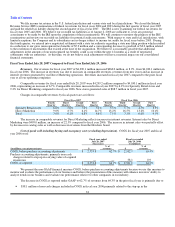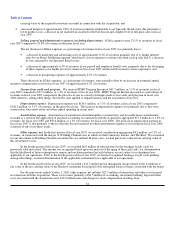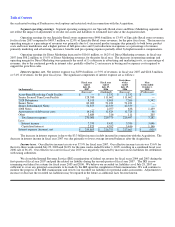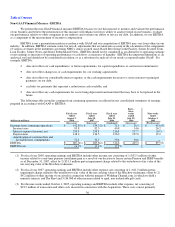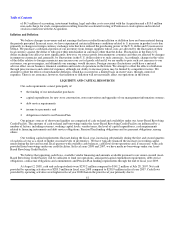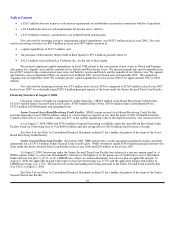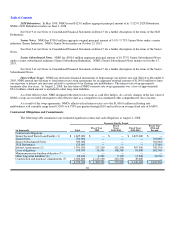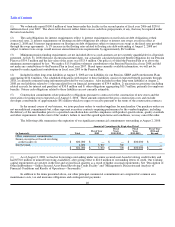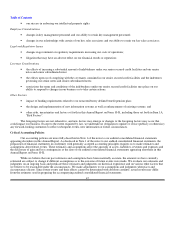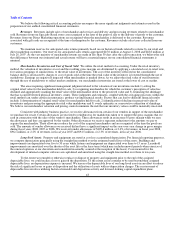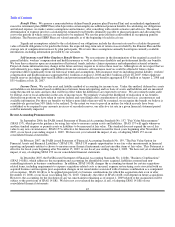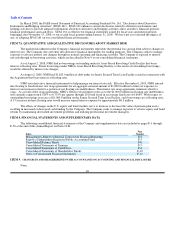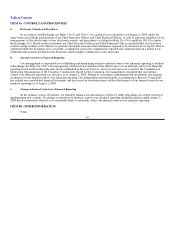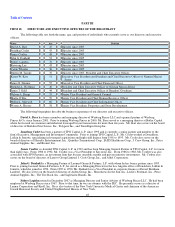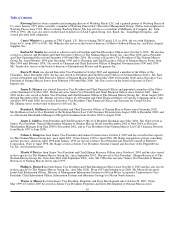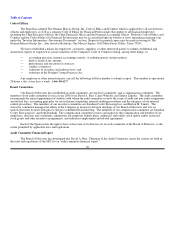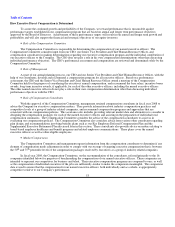Neiman Marcus 2007 Annual Report Download - page 47
Download and view the complete annual report
Please find page 47 of the 2007 Neiman Marcus annual report below. You can navigate through the pages in the report by either clicking on the pages listed below, or by using the keyword search tool below to find specific information within the annual report.
Table of Contents
We believe the following critical accounting policies encompass the more significant judgments and estimates used in the
preparation of our audited consolidated financial statements.
Revenues. Revenues include sales of merchandise and services and delivery and processing revenues related to merchandise
sold. Revenues from our Specialty Retail stores are recognized at the later of the point of sale or the delivery of goods to the customer.
Revenues from our Direct Marketing operations are recognized when the merchandise is delivered to the customer. Revenues
associated with gift cards are recognized at the time of redemption by the customer. Revenues exclude sales taxes collected from our
customers.
We maintain reserves for anticipated sales returns primarily based on our historical trends related to returns by our retail and
direct marketing customers. Our reserves for anticipated sales returns aggregated $45.0 million at August 2, 2008 and $48.8 million at
July 28, 2007. As the vast majority of merchandise returns are made in less than 30 days after the sales transaction, we believe the risk
that differences between our estimated and actual returns will have a material impact on our consolidated financial statements is
minimal.
Merchandise Inventories and Cost of Goods Sold. We utilize the retail method of accounting. Under the retail inventory
method, the valuation of inventories at cost and the resulting gross margins are determined by applying a calculated cost-to-retail ratio,
for various groupings of similar items, to the retail value of inventories. The cost of the inventory reflected on the consolidated
balance sheets is decreased by charges to cost of goods sold at the time the retail value of the inventory is lowered through the use of
markdowns. Earnings are negatively impacted when merchandise is marked down. As we adjust the retail value of our inventories
through the use of markdowns to reflect market conditions, our merchandise inventories are stated at the lower of cost or market.
The areas requiring significant management judgment related to the valuation of our inventories include 1) setting the
original retail value for the merchandise held for sale, 2) recognizing merchandise for which the customer's perception of value has
declined and appropriately marking the retail value of the merchandise down to the perceived value and 3) estimating the shrinkage
that has occurred between physical inventory counts. These judgments and estimates, coupled with the averaging processes within the
retail method can, under certain circumstances, produce varying financial results. Factors that can lead to different financial results
include 1) determination of original retail values for merchandise held for sale, 2) identification of declines in perceived value of
inventories and processing the appropriate retail value markdowns and 3) overly optimistic or conservative estimation of shrinkage.
We believe our merchandise valuation and pricing controls minimize the risk that our inventory values could be materially misstated.
Consistent with industry business practice, we receive allowances from certain of our vendors in support of the merchandise
we purchase for resale. Certain allowances are received to reimburse us for markdowns taken or to support the gross margins that we
earn in connection with the sales of the vendor's merchandise. These allowances result in an increase to gross margin when we earn
the allowances and they are approved by the vendor. Other allowances we receive represent reductions to the amounts we pay to
acquire the merchandise. These allowances reduce the cost of the acquired merchandise and are recognized at the time the goods are
sold. The amounts of vendor allowances we received did not have a significant impact on the year-over-year change in gross margin
during fiscal years 2008, 2007 or 2006. We received vendor allowances of $109.6 million, or 2.4% of revenues, in fiscal year 2008,
$96.1 million, or 2.2% of revenues, in fiscal year 2007 and $94.5 million, or 2.3% of revenues, in fiscal year 2006.
Long-lived Assets. Property and equipment are stated at cost less accumulated depreciation. For financial reporting purposes,
we compute depreciation principally using the straight-line method over the estimated useful lives of the assets. Buildings and
improvements are depreciated over five to 30 years while fixtures and equipment are depreciated over three to 15 years. Leasehold
improvements are amortized over the shorter of the asset life or the lease term (which may include renewal periods when exercise of
the renewal option is at our discretion and considered reasonably assured at the inception of the lease). Costs incurred for the
development of internal computer software are capitalized and amortized using the straight-line method over three to ten years.
To the extent we remodel or otherwise replace or dispose of property and equipment prior to the end of the assigned
depreciable lives, we could realize a loss or gain on the disposition. To the extent assets continue to be used beyond their assigned
depreciable lives, no depreciation expense is incurred. We reassess the depreciable lives of our long-lived assets in an effort to reduce
the risk of significant losses or gains at disposition and the utilization of assets with no depreciation charges. The reassessment of
depreciable lives involves utilizing historical remodel and disposition activity and forward-looking capital expenditure plans.
43


